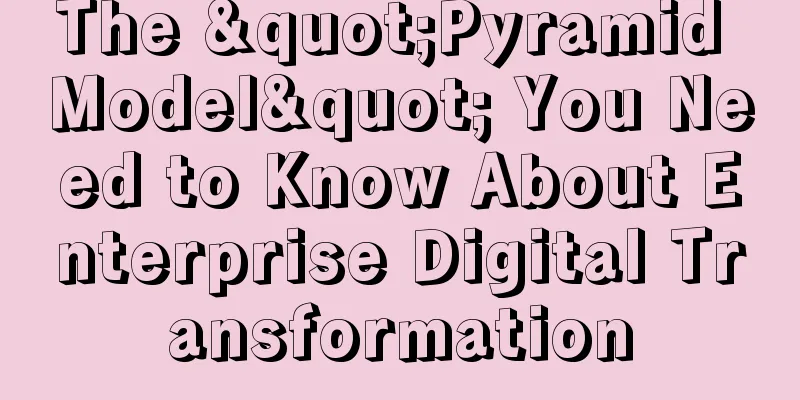The "Pyramid Model" You Need to Know About Enterprise Digital Transformation

For enterprises to implement successful digital marketing transformation reforms, they need to practice the following pyramid model, which from top to bottom is cognition, application, process and organization. Let’s break them down one by one. 1. The first layer: cognitive layerAt the top is the cognitive layer. Without the awareness of digital marketing, it is difficult to implement a thorough reform, and usually the project will abort halfway. The awareness here includes the awareness of at least two levels of management. 1. First level of managementThe first layer is the top management level CXO, namely CEO, CMO, and CFO. The CEO is responsible for approving the entire digital marketing transformation strategy, the CMO is responsible for the output of digital marketing upper-level methodology, the establishment of marketing management processes, the implementation of digital means and the establishment of digital marketing organizations, and the CFO is responsible for budget approval. 2. Second level of managementThe second level is the awareness of middle-level management, such as the marketing director, e-commerce director, digital marketing director, sales director, sales excellence director (many large companies have this department, whose main task is to optimize the structure and methods of the sales department, output the best sales methods, and improve sales funnel performance), and any other department heads related to the digital marketing transformation project. Why are they so important? Marketing transformation usually requires the cooperation of multiple departments. Common reasons for project failure are unclear responsibilities between departments, conflicts of interest among middle management, and insufficient coordination of goals. For example, the sales department usually has conflicts with the e-commerce department over pricing issues, fearing that new channels will seize the sales prices of traditional channels. In the cognitive stage of digital marketing, users must change their purchasing habits and shift from offline to online, and price concessions are inevitable. If cognition is not established, it will be difficult to reach a consensus on this. The inevitable result of high prices is poor online sales, which in turn becomes the reason for the failure of digital marketing projects. Obviously, this is a vicious cycle that is not conducive to the advancement of marketing reforms. This can be done through other means, such as launching online-only models, making appropriate concessions at specific stages, and also giving special discounts to offline dealers with good performance, so as to achieve cognitive synergy and online and offline collaboration. For example, in digital marketing projects, there is usually a critical BDR department (business development representative). They do not face customers, but they are the first brand personnel to contact customers through outbound calls. Therefore, their conversation and communication methods directly determine the customer's impression of the brand. Who is in charge of this department, the sales department, the channel department, or the digital marketing department? The department they belong to basically determines their KPI assessment and the way they communicate with customers. Some of this department are even under the customer service team. Their main assessment indicators are customer satisfaction and sales satisfaction. Customer satisfaction is actually an important indicator of marketing, but sales satisfaction is very problematic. The reason for the existence of this department is not to make sales happy. Sales cannot say that this customer is small, so why are the leads from your BDR department so poor? Instead of using this as an excuse to complain, small customers can very likely become big customers through sufficient exploration by sales. Therefore, in addition to customer satisfaction, this department should also be evaluated on the conversion rate of leads into MQL/SQL. Has it assumed an excellent lead-in, using its sufficient professional knowledge and communication methods to convert customers into high-intent potential customers who are willing to be further contacted by sales when they first come into contact with customers? 2. The second layer: process layerThe second layer is the process layer. The establishment of the process is second only to cognition and higher than application. Why? Once the process is established, no matter how the personnel flow or how the marketing strategy changes, the establishment of the process is conducive to improving marketing efficiency, the scale and replicability of marketing methods. The key to establishing a digital marketing process is to make full use of digital technology, systems, tools and means to achieve efficiency improvement brought by marketing automation. We take the digitization of exhibitions as an example to establish the digital marketing process. How to digitize traditional exhibitions? 1. Establish a digital user experience processStarting from when users learn about the exhibition through various channels such as the official website, WeChat, mini-programs, Moments, offline posters, etc., the brand guides users to log in to the micro-website or mini-program to navigate the exhibition information, view brand highlights, new product release information, and experience the Metaverse virtual exhibition (the content and experience forms can be very diverse) to attract users to leave information for the lottery. In the later stage, the brand incubates leads through the Marketo system, and the BDR team follows up in a timely manner, converts sales visits, and follows up on transaction records in the Salesforce system. The brand uses this to depict the user experience process. The front end is a visible user experience journey, and the back end is the lead follow-up, conversion measures, and data flow and connection between various systems implemented by the brand through digital tools. 2. Deploy and integrate digital marketing systemsDeploy marketing systems and tools according to specific business needs. Use monitoring tools such as Adobe Analytics and Gridsum for website data analysis to monitor page traffic, bounce rate, listening time, etc. Use marketing tools such as Marketo, Pardot, Eloqua, and Adobe Target for email automation marketing. Use more localized SCRM tools such as Beschannel and Sinobase on WeChat to achieve the purpose of user tagging, grouping, and batch accurate information reach. At the same time, after the system is deployed, it is necessary to complete the field docking with other systems such as CRM tools Salesforce to complete the automatic transmission and circulation of data. The construction, deployment, and application of digital marketing systems is a huge project that requires the joint collaboration of strategy teams, enterprise architecture, IT project delivery teams, and digital marketing teams to complete. 3. Create a marketing automation processThe digital marketing of the exhibition is established in different stages. Warm-up begins one week in advance. Customers are pushed messages through WeChat templates three days in advance to remind them that the exhibition is about to take place. Reminders are given again one day and one hour in advance, and they are informed of the exciting activities on site. After the exhibition, customers are sent the highlights of the exhibition, and users are invited to participate in customer satisfaction surveys and the next exciting exhibition is announced. Through full-link communication and tracking before and after the exhibition, high-frequency interaction with users is established, and user favor is gained by providing actual benefits of services. The benefit of establishing a marketing automation process is that the traditional method of notifying customers one by one through phone calls or WeChat can now be transformed into batch and large-scale notifications to target audiences with the same "user tags" and who are interested in the exhibition through WeChat template messages, EDM emails, SMS text messages, etc., so the efficiency of customer communication is greatly improved. 4. Establish a unified KPI assessment mechanismWe can establish assessment indicators in several dimensions, such as Educate, Engage, and Advocate, which is a customer-centric approach. In the indicator of "customer education", we can set how many WeChat fans have been added through this exhibition, how many users have been reached through the media if media has been purchased, how many WeChat public accounts have been read, etc.; in the indicator of interaction, we can set the number of comments and likes on WeChat tweets and video accounts, the number of participants in the Metaverse virtual exhibition hall, the number of information left, etc. In the indicator of Advocate, we can set more in-depth indicators such as forwarding, generating SCRM traceability posters, the number of secondary forwardings brought about by this, and the number of business opportunities brought about. The indicators of the three dimensions are submitted layer by layer to help measure the actual effect of digital marketing and put forward practical and feasible suggestions for improvement. The digital marketing process is not just one process, it can be composed of many parts. The above example is the process of digital marketing for exhibitions. Other different digital marketing methods such as website marketing, social media marketing, employee marketing, etc. can establish related processes. Once the process is established, similar marketing activities, or similar activities by other business units, can be replicated on a large scale and used right away, avoiding the waste of marketing resources caused by repeated formulation of strategies and processes for similar activities. The inevitable result of saving marketing costs and manpower is the improvement of efficiency. Another major advantage of process establishment is that the process can be continuously optimized in the practice of repeated marketing activities to achieve the goal of improving marketing effectiveness. 3. Layer 3: Application LayerThe next layer after the process layer is the application layer. Under the guidance of the process layer, applications are carried out according to actual conditions and different scenarios. Taking the exhibition as an example again, the digital journey, assessment indicators, and marketing system deployment and integration, after the establishment of the automated process, the specific content of the exhibition, whether it is inviting celebrities to give lectures, holding roundtable activities, or launching new products, is an application-level matter and can be changed every time. The application layer refers to the cross-integrated application of digital marketing methods and the application of digital marketing tools. Digital marketing methods include official website marketing, content marketing, social media (WeChat official accounts, video accounts, Douyin, Bilibili, etc.) marketing, purchased media marketing (Paid Media), live e-commerce, employee sales, etc. The application of digital marketing tools refers to how the system is used to benefit the business, decide which modules of the system to use, and what purpose to meet, so this is a matter of both strategy and execution. The application level is mainly determined by the following factors: 1. User characteristicsWhether the customer is a B2B or B2C customer, what are their media consumption habits, what kind of content they like to consume, what they are interested in, what industry they are in, etc. determine the user portrait, which in turn affects the construction of the user tag system and also determines what channels, content, and forms are suitable for marketing. 2. Marketing objectivesWhether the marketing goal is mainly based on brand awareness and favorability, acquiring new users, or increasing the value of existing customers also determines the application of different marketing methods and tools. 3. Resources and budgetThe objective situation faced by many companies is that there is an extremely tight shortage of marketing personnel and budgets. Especially during the three years of economic downturn caused by the epidemic, corporate performance has been affected, and the first to be hit is budget cuts. Therefore, limited resources can only be invested in areas that can generate the greatest ROI (return on investment). For example, media marketing activities that can only generate a large amount of exposure are abandoned, and turned to more economical private domain user operations, and higher business opportunity conversions are obtained through long-term, relatively low-cost private domain user operations and content marketing optimization. 4. The fourth layer: organizational layerThe most basic and fundamental thing is the establishment of a digital marketing organizational structure. Any successful marketing activity or marketing project cannot be separated from a good team and the collaboration between team members. Building a successful digital marketing organization requires several elements: First, build an organization according to the characteristics of the enterprise and the different stages of digital marketing, and adapt to the times and local conditions. If the enterprise itself is in the start-up stage, it is not appropriate to build a large organization. Start by setting up 1-2 positions that the company leaders think are the most important and most helpful to the business development of the enterprise. For relatively mature enterprises, it is imperative to set up a digital marketing department and conceive the division of labor among department personnel. In large multinational companies with different business units, this situation is the most complicated, which is related to the organizational coordination between the global headquarters and the local market, and between business units. Some of them concentrate the digital marketing department into a functional department to support the work of different local business units, and some of them have their own separate digital marketing departments or personnel in each business unit. This is an organizational model that is mainly oriented towards supporting business. There is also a hybrid organization, in which a digital marketing department is established at the enterprise level, and digital marketing personnel supporting the business unit are also established in the business unit. Marketing activities are achieved through full coordination between different departments. The second is to find a suitable person in charge of digital marketing, authorize him to find digital marketing talents, and build a team. Usually due to the reduction of corporate personnel budget, a digital marketer usually has to take on all aspects of work. It seems cost-effective, but it is not, because the work cannot be done very finely, and it is impossible for a person to be very proficient in all areas of digital marketing. From the perspective of responsibilities, it covers project management, strategy formulation, execution and operation, reporting upward, process formulation and optimization, etc. From the perspective of functions, it includes official website operation, search engine marketing, social media marketing, content marketing, big data marketing, marketing automation, etc. It is ideal to have experts in each field in each position. The third is the collaborative goal, which is broken down to each person, with clear division of labor and clear responsibilities. Finally, develop an appropriate incentive mechanism to objectively evaluate the performance of members through the achievement of quantified results and the quality of completed and delivered projects, and provide appropriate incentives in terms of both material and spiritual benefits to achieve both differentiation and fairness. V. ConclusionTo summarize the main points of this article, a pyramid model for digital marketing strategy transformation is constructed:
Author: Zhu Jingyu Source: WeChat official account "Jade Digital Marketing (ID: Jade_Digital)" |
<<: This inconspicuous product sold over 100,000
>>: Durex live broadcast, 3 million people just watched but didn't buy
Recommend
What are the advantages of Amazon video marketing?
Video marketing has always been an important part ...
How to reap the benefits of Xiaohongshu e-commerce? How to achieve high investment and high yield?
How to reap the benefits of Xiaohongshu's e-co...
40 years of changes in New Year's goods: a history of consumption upgrade
Every Spring Festival, buying New Year's goods...
HEYTEA FENDI co-branded drinks are being snapped up: Mini Program crashes multiple times, scalpers double the price
HEYTEA has partnered with luxury brand Fendi to la...
What does a cross-border third-party payment platform mean? What are its advantages?
There are many payment methods that can be support...
How did electric welding become popular in Foshan? What do you think about the viral spread of imitation actions?
Do you remember the popular Foshan welding? Do you...
Does Lazada require a credit card? Are there risks in paying with a credit card?
In the digital age, the rise of e-commerce platfor...
Starting a nationwide layout: the core competitiveness and membership store trend of fresh food supply chain company Fudi
Against the backdrop of increasingly fierce compet...
Is there a limit on PayPal withdrawals? How is the handling fee charged?
Nowadays, more and more people are trying to do cr...
What are the cross-border payment app platforms? Tell you how to choose
With the continuous development of the global econ...
Can Amazon advertising bids be adjusted daily? How long does it take for the adjustment to take effect?
Amazon Advertising is an important marketing tool ...
A TikTok account you’ll want to buy at first sight!
How merchants operate an account well, shooting, b...
In the past year, the transaction volume exceeded one million just by relying on Xiaohongshu's search results. How can we find the new volume when the data of notes is declining?
In recent years, the pet market has been developin...
8 favorite sentences in July
This article selects 8 sentences from July, which ...
Replay of "Black Friday": Temu still need to pay a huge tuition
As the predecessor of Double Eleven in the Europea...









